Master Air Rifle Maintenance: 12 Professional Servicing Techniques for Peak Performance
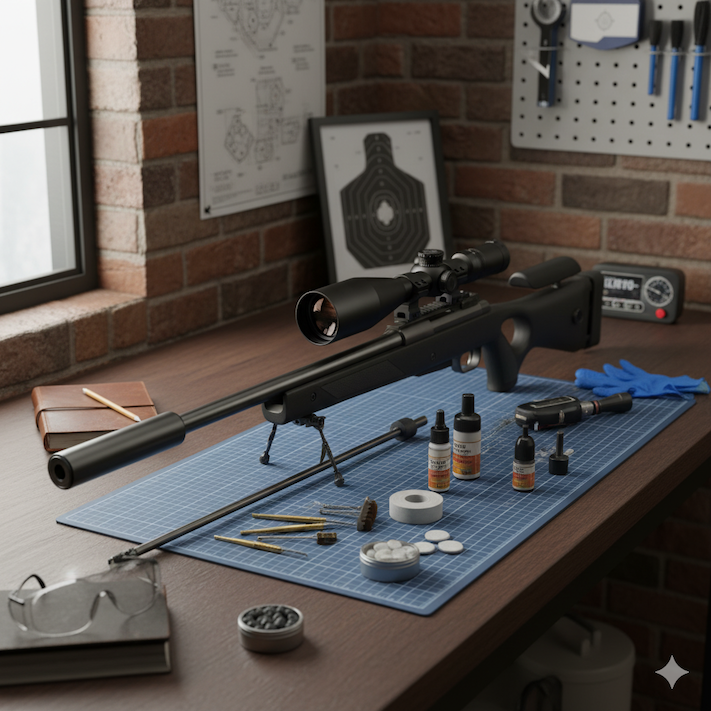
Your air rifle’s performance doesn’t have to decline with age – discover how proper maintenance can keep it shooting like new for years to come. Many UK air rifle owners struggle with maintaining their equipment, leading to decreased accuracy and costly repairs that could have been easily prevented with the right knowledge and approach.
The truth is, a well-maintained air rifle can deliver consistent accuracy and power for decades, whilst a neglected one might start showing performance issues within just a few hundred shots. Whether you’re a dedicated pest controller, competition shooter, or recreational enthusiast, understanding proper air rifle maintenance isn’t just about preserving your investment – it’s about ensuring every shot counts when it matters most.
This comprehensive air rifle maintenance guide will transform you from someone who simply cleans their rifle occasionally into a confident owner who can diagnose issues early, perform professional-grade servicing, and optimise performance through systematic care. You’ll learn the same techniques used by professional gunsmiths, adapted for the home workshop and tailored specifically for UK conditions and regulations.
Throughout this guide, we’ll cover 12 essential maintenance tasks that form the foundation of proper air rifle care. From basic cleaning protocols that prevent accuracy drift to advanced seal maintenance that preserves power consistency, each technique is presented with clear step-by-step instructions and professional insights gained from years of workshop experience.
By the time you’ve finished reading, you’ll have the knowledge to create personalised maintenance schedules based on your shooting frequency, understand exactly when DIY maintenance is appropriate versus professional servicing, and most importantly, maintain your air rifle’s peak performance throughout its working life. Let’s begin with understanding what your air rifle actually needs to stay in optimal condition.
Understanding Your Air Rifle’s Maintenance Needs
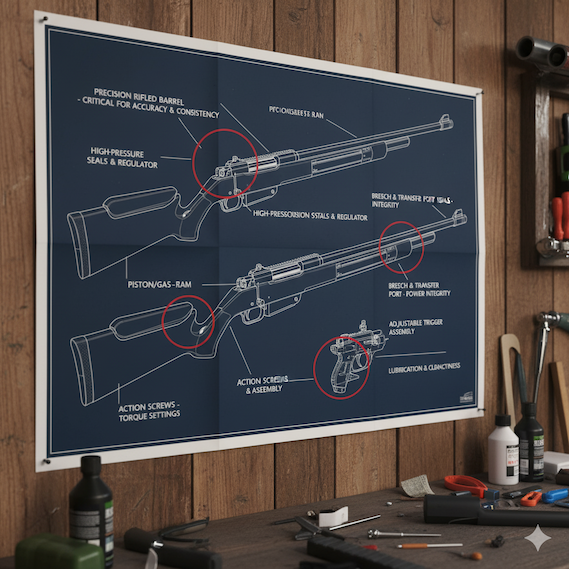
Critical Components Requiring Regular Maintenance
Every air rifle, regardless of type or manufacturer, contains several critical components that directly impact accuracy, power, and reliability. Understanding these components and their maintenance requirements forms the foundation of any effective air rifle maintenance guide.
The barrel represents your rifle’s most crucial component for accuracy. Even microscopic fouling buildup can significantly impact grouping consistency, whilst corrosion can permanently damage rifling and destroy precision. UK’s varied weather conditions make barrel maintenance particularly critical, as moisture from morning hunts or competition shoots can lead to rapid deterioration if not properly addressed.
Your rifle’s compression system – whether spring-piston, gas-ram, or PCP – contains numerous wear components that require regular attention. Spring-piston rifles feature mainsprings under constant compression, piston seals that create the air cushion for pellet propulsion, and breech seals that must maintain perfect compression. Gas-ram systems substitute a gas strut for the spring but still rely on critical seals and precise tolerances.
PCP rifles present their own maintenance challenges with high-pressure seals, regulators, and fill systems that demand specialised care. The O-rings and seals in these systems operate under extreme pressures and require specific maintenance protocols to prevent catastrophic failures.
The trigger mechanism, often overlooked, contains precision components that can significantly impact shooting performance when neglected. Accumulated debris, improper lubrication, or wear can transform a crisp, predictable trigger into an unreliable hindrance to accuracy.
Stock and metalwork maintenance extends beyond aesthetics – loose action screws can destroy accuracy, whilst unprotected metal surfaces can develop corrosion that affects both appearance and functionality. UK shooting often involves exposure to harsh weather conditions that accelerate wear without proper protection.
Neglecting any of these components creates a cascade effect where minor issues compound into major problems. A slightly dirty barrel might reduce accuracy by a few millimetres at 25 metres, but combined with a deteriorating piston seal and loose action screws, that accuracy degradation becomes severe enough to affect pest control effectiveness or competition performance.
Signs Your Air Rifle Needs Attention
Recognising early warning signs prevents minor maintenance needs from becoming expensive repair requirements. Your air rifle constantly communicates its condition through subtle performance changes that, once understood, provide invaluable maintenance guidance.
Accuracy degradation rarely occurs suddenly – it typically develops gradually as various components accumulate wear or contamination. If your groups have opened up from 15mm to 25mm at your usual shooting distance, don’t immediately blame your technique or pellets. Instead, consider when you last performed thorough barrel cleaning or checked action screw torque.
Power consistency issues manifest as increased velocity spread between shots, with chronograph readings showing greater standard deviation than typical for your rifle and pellet combination. A well-maintained springer might show velocity variations of 10-15 fps, whilst a neglected one could vary by 50 fps or more, making accurate range estimation impossible.
Unusual noises during firing often indicate developing problems. Spring-piston rifles naturally produce distinct firing characteristics, but changes in the firing cycle – whether sharper reports, different recoil impulses, or metallic sounds during cocking – suggest internal component wear or damage.
Visual inspection reveals numerous maintenance indicators. Examine your barrel crown for damage or fouling buildup, check metal surfaces for early corrosion signs, and inspect the stock for cracks or loose bedding. Pellet examination after firing can reveal valuable information – excessive leading, deformed skirts, or unusual wear patterns indicate specific maintenance needs.
Performance inconsistency between shooting sessions, even with identical ammunition and conditions, typically indicates developing maintenance issues. Professional target shooters maintain detailed logbooks tracking performance metrics specifically to identify maintenance requirements before they affect competition results.
Understanding these warning signs allows proactive maintenance scheduling rather than reactive repairs, ultimately saving both money and shooting opportunities whilst maintaining peak performance.
Essential Maintenance Tools and Supplies
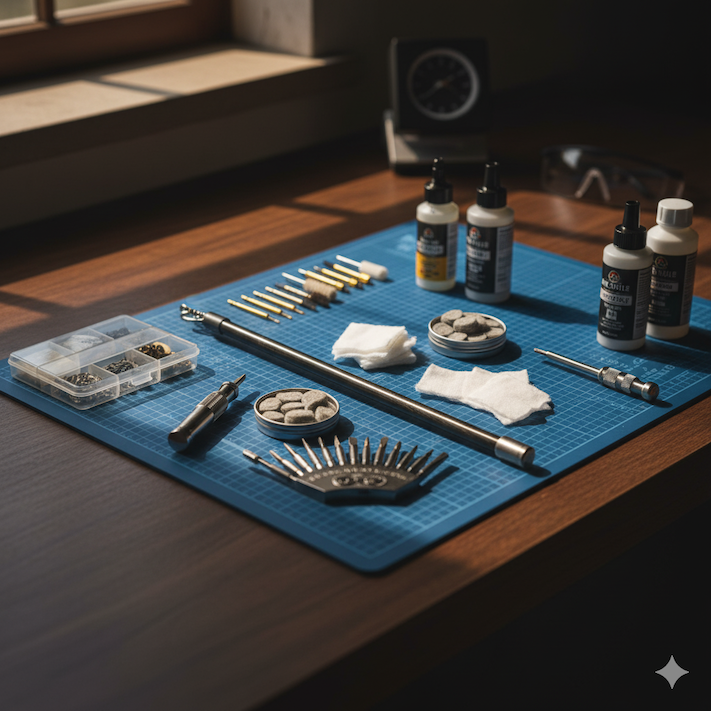
Basic Maintenance Kit Components
Building a comprehensive maintenance kit represents one of the most important investments any serious air rifle owner can make. The right tools not only make maintenance tasks more efficient but also help prevent damage that can occur when using improvised or inappropriate equipment.
Your cleaning rod selection forms the foundation of barrel maintenance. Avoid cheap, multi-piece steel rods that can damage rifling – instead, invest in a quality one-piece carbon fibre or coated steel rod specifically designed for your calibre. Carbon fibre rods offer excellent durability without the risk of barrel damage, whilst high-quality coated steel rods provide superior rigidity for stubborn fouling removal.
Cleaning pellets and patches serve different but complementary purposes in barrel maintenance. Felt cleaning pellets excel at removing loose fouling and applying solvents, whilst patches provide superior scrubbing action for stubborn deposits. Stock both in your rifle’s calibre, ensuring patches fit snugly without excessive force.
Appropriate solvents and lubricants represent critical components often overlooked by novice maintainers. Avoid general-purpose gun oils for precision applications – instead, select products specifically formulated for air rifle use. These products consider the unique requirements of air rifle seals and the lower operating temperatures compared to firearms.
A comprehensive brush selection includes both brass and nylon options in appropriate calibres. Brass brushes effectively remove stubborn fouling without damaging rifling when used correctly, whilst nylon brushes safely clean delicate areas and apply solvents evenly.
Basic hand tools should include appropriate screwdrivers for your rifle’s action screws, with hollow-ground tips that properly fit screw slots without causing damage. A torque wrench becomes essential for rifles requiring specific action screw settings, ensuring consistent bedding pressure without over-tightening.
Cleaning solvents must be selected carefully for air rifle applications. Many traditional firearm solvents prove too aggressive for air rifle seals and finishes. Choose products specifically formulated for air rifles, considering both effectiveness and component compatibility.
A quality maintenance mat protects work surfaces whilst providing a clean, organised workspace. Look for mats with component diagrams for your specific rifle model – these prove invaluable during disassembly and reassembly procedures.
Advanced Tools for Detailed Servicing
Professional-level maintenance requires specialised tools that enable precision work impossible with basic equipment. These tools represent significant investments but prove essential for serious enthusiasts who prefer comprehensive DIY maintenance.
A spring compressor becomes indispensable for spring-piston rifle maintenance. Quality units allow safe spring compression for piston seal replacement, cleaning, and lubrication without the extreme danger posed by improvised compression methods. Never attempt spring compression without proper tools – the stored energy can cause severe injury or death.
Precision measuring equipment, including micrometers and feeler gauges, enables accurate assessment of component wear and proper adjustment of critical tolerances. Piston-to-cylinder clearances, trigger adjustments, and barrel-to-action fit all require precise measurement for optimal performance.
Specialised seal removal and installation tools prevent damage to expensive components whilst ensuring proper seating and alignment. Generic picks and punches often damage seals or their seating surfaces, creating leak paths that compromise performance.
A quality chronograph provides objective performance measurement essential for maintenance scheduling and troubleshooting. Velocity consistency, power output trends, and the effectiveness of maintenance procedures can only be accurately assessed with chronograph data.
Ultrasonic cleaning equipment revolutionises small component maintenance, removing contamination impossible to address with conventional cleaning methods. Trigger components, small screws, and intricate metalwork benefit tremendously from ultrasonic cleaning when properly executed.
Professional-grade lubricants and sealants enable maintenance quality impossible with basic products. These specialised compounds consider the unique operating conditions within air rifles, providing superior performance and longevity compared to general-purpose alternatives.
The 12 Essential Maintenance Tasks
Basic Cleaning and Lubrication
Task 1: Systematic Barrel Cleaning
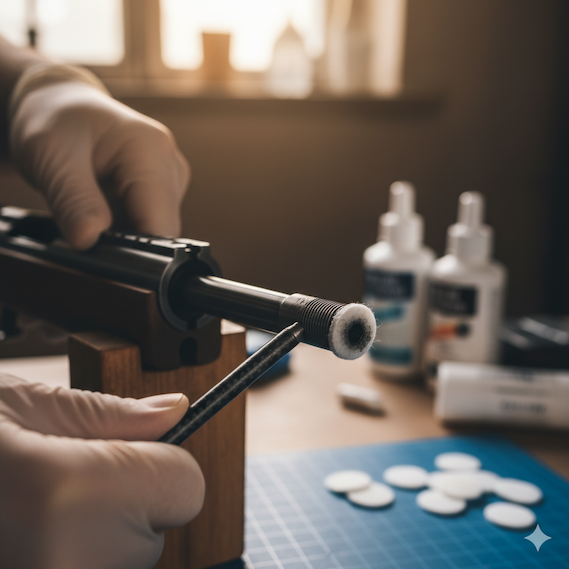
Proper barrel cleaning forms the cornerstone of air rifle maintenance, directly impacting accuracy and preventing permanent rifling damage. Begin by ensuring your rifle is unloaded and pointed in a safe direction, then remove the bolt or break the action to access the breech end.
Start with dry cleaning using felt pellets pushed from breech to muzzle in single strokes, never reversing direction within the barrel. This initial step removes loose fouling without grinding particles against the rifling. Continue until pellets emerge clean, typically requiring 3-5 pellets for a lightly fouled barrel.
Apply cleaning solvent to a fresh felt pellet, allowing it to dissolve stubborn deposits for several minutes before pushing through. Follow with alternating wet and dry pellets until no fouling appears on emerging pellets. Pay particular attention to the chamber area where pellet seating occurs – fouling here directly affects accuracy.
For stubborn deposits, use a brass brush sparingly, limiting passes to prevent rifling damage. Always push from breech to muzzle, removing the rod completely before inserting for the next stroke. Excessive brushing causes more damage than benefit – patience with solvents proves more effective than aggressive scrubbing.
Complete the cleaning process with clean, dry patches until they emerge spotless. Apply a light coat of appropriate barrel preservative if the rifle will be stored, but ensure complete removal before use as residual oil affects initial shot placement.
Task 2: Action Cleaning and Lubrication
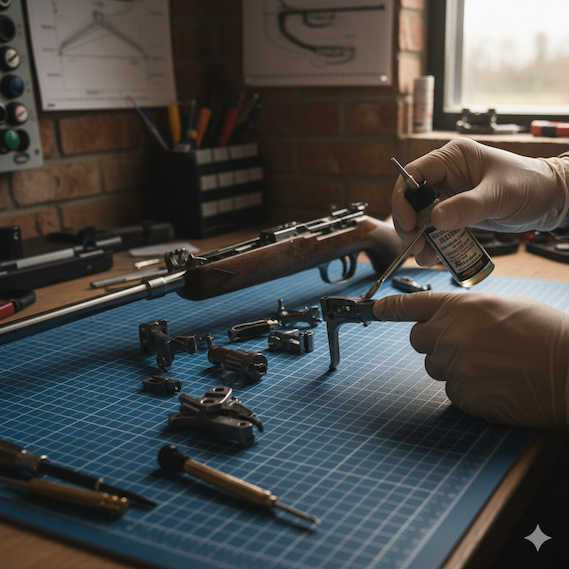
The action houses your rifle’s most critical mechanical components, requiring systematic cleaning and precise lubrication for optimal performance. Remove the action from the stock following manufacturer procedures, typically involving 2-3 action screws that require specific torque settings during reassembly.
Clean all accessible surfaces with appropriate solvents, paying special attention to the trigger mechanism and bolt areas where fouling accumulates. Use small brushes and cotton swabs to reach intricate areas, ensuring complete removal of old lubricants and contamination.
Apply fresh lubrication sparingly to wear points identified in your rifle’s manual. Over-lubrication attracts contamination and can affect trigger function – use only the minimum quantity required for proper operation. Focus on pivot points, bearing surfaces, and areas showing wear patterns.
Task 3: Stock Maintenance and Bedding Inspection
Wood and synthetic stocks require different maintenance approaches but equally systematic attention. Inspect the bedding area for cracks, wear, or looseness that can destroy accuracy through inconsistent barrel-to-action contact.
Clean the stock thoroughly, addressing any damage immediately to prevent deterioration. Wood stocks may require refinishing or oil treatment to maintain weather resistance, whilst synthetic stocks need inspection for stress cracks around action screw areas.
Check action screw torque using appropriate tools, ensuring consistent bedding pressure without over-tightening that can crack the stock or distort the action. Record torque settings for future reference, maintaining consistency across maintenance sessions.
Seal and O-Ring Maintenance
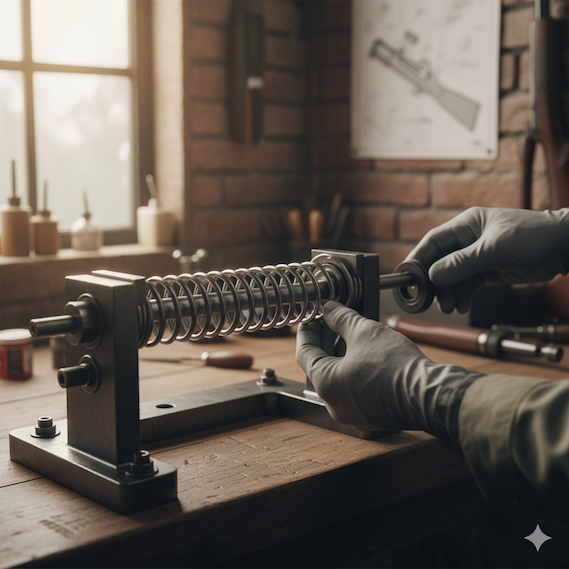
Task 4: Piston Seal Inspection and Replacement
The piston seal creates the air cushion that propels your pellet, making its condition critical for both power and accuracy consistency. Regular inspection reveals wear patterns that indicate replacement needs before performance degradation becomes noticeable.
Remove the action from the stock and compress the mainspring safely using appropriate tools. Never attempt this without proper spring compressors – the stored energy can cause fatal injuries. Once compressed, the piston assembly becomes accessible for seal inspection.
Examine the seal for cuts, hardening, or dimensional changes that indicate replacement needs. New seals should be supple and show consistent dimensions around their circumference. Install replacement seals carefully, ensuring proper orientation and seating without damage during assembly.
Task 5: Breech Seal Maintenance
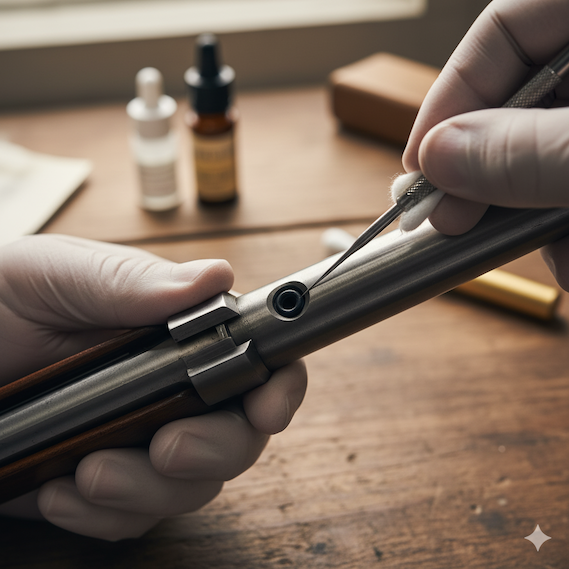
The breech seal prevents pressure loss during pellet propulsion, directly affecting both power output and shot-to-shot consistency. This critical component requires regular inspection and occasional replacement to maintain optimal performance.
Access the breech seal by removing the barrel assembly or opening the action sufficiently to expose the seal area. Inspect for cuts, compression set, or contamination that can create leak paths reducing performance.
Clean the seal and its seating surface thoroughly before applying appropriate seal conditioner. This treatment restores elasticity and extends service life, often eliminating the need for premature replacement.
Task 6: O-Ring System Maintenance (PCP Rifles)
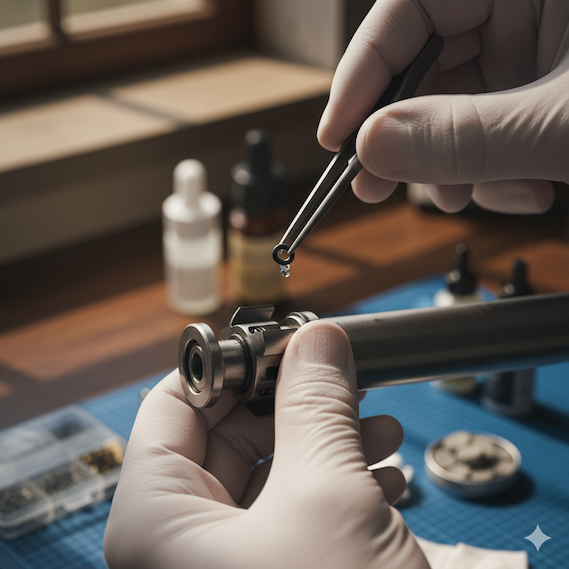
PCP rifles contain numerous O-rings operating under extreme pressures, requiring systematic inspection and maintenance to prevent catastrophic failures. Create a maintenance schedule based on shot count and pressure cycling frequency.
Inspect O-rings for cuts, nicks, or compression set using appropriate magnification. Replace any damaged O-rings immediately – attempting to reuse compromised seals can result in dangerous failures and expensive damage.
Apply appropriate O-ring lubricant during installation, ensuring proper seating without twisting or pinching. Use only lubricants specifically approved for high-pressure air service, as inappropriate products can cause seal swelling or degradation.
Spring and Piston Care
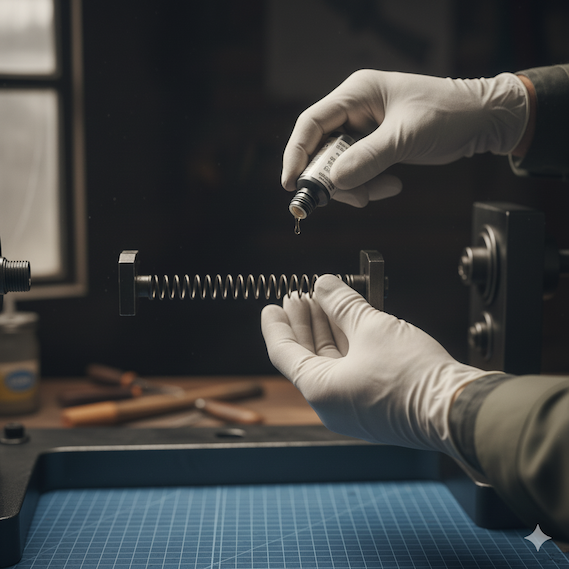
Task 7: Mainspring Inspection and Maintenance
The mainspring provides the energy for pellet propulsion in spring-piston rifles, requiring periodic inspection and maintenance to ensure consistent performance. Spring degradation occurs gradually, often going unnoticed until significant power loss develops.
Compress the spring safely and inspect its entire length for breaks, corrosion, or coil binding. Measure free length and compare to specifications – springs typically lose tension gradually through normal use, indicating replacement needs before failure occurs.
Clean the spring thoroughly and apply appropriate lubrication to prevent corrosion and reduce friction. Avoid over-lubrication that can cause dieseling – use only products specifically designed for air rifle spring systems.
Task 8: Piston and Cylinder Maintenance
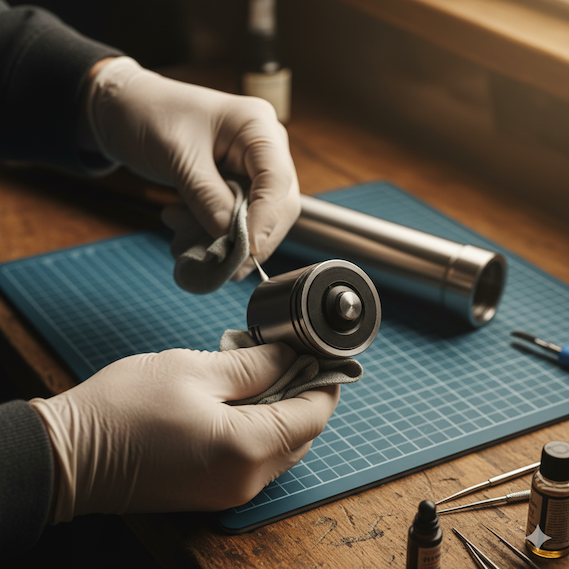
The piston and cylinder form the heart of your rifle’s compression system, requiring precise maintenance for optimal performance and longevity. Wear in these components directly affects both power output and shot cycle characteristics.
Inspect the piston for scoring, wear, or damage that can affect seal performance or create excessive blow-by. Minor surface imperfections often respond to careful polishing, whilst major damage requires professional attention or component replacement.
Clean the cylinder bore thoroughly, removing all traces of old lubricants and contamination. Inspect for scoring or corrosion that can damage piston seals or affect compression efficiency. Apply fresh lubrication according to manufacturer specifications.
Task 9: Cocking Linkage and Safety Mechanism Service

The cocking mechanism and safety systems require regular maintenance to ensure reliable operation and prevent dangerous malfunctions. These components often receive minimal attention despite their critical importance for safe operation.
Disassemble the cocking linkage carefully, noting component orientation and assembly sequence. Clean all components thoroughly and inspect for wear, damage, or improper adjustment that can affect reliability.
Test safety mechanism operation throughout the maintenance process, ensuring positive engagement and release under all conditions. Never compromise safety system integrity for convenience – any questionable operation requires immediate professional attention.
Advanced System Maintenance
Task 10: Trigger System Overhaul
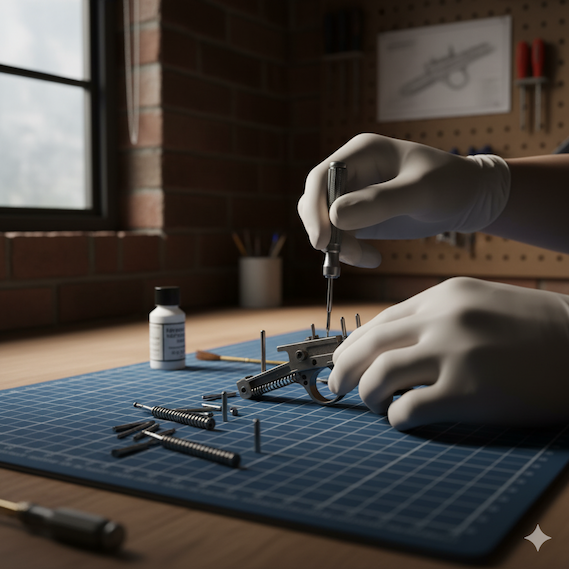
A quality trigger enhances shooting performance dramatically, making its maintenance a priority for serious shooters. Modern air rifle triggers contain precision components requiring careful attention and proper adjustment procedures.
Disassemble the trigger mechanism completely, photographing assembly sequences to ensure correct reassembly. Clean all components thoroughly using appropriate solvents and tools, removing accumulated fouling and old lubricants.
Adjust trigger pull weight, overtravel, and engagement according to manufacturer specifications and your preferences. Document final settings for future reference, ensuring consistency across maintenance intervals whilst maintaining safe operation.
Task 11: Scope and Mounting System Maintenance
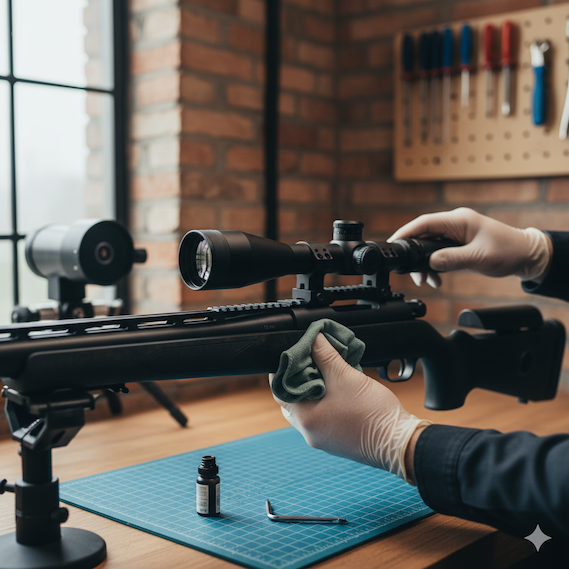
Your scope and mounting system require systematic maintenance to preserve zero and ensure reliable performance. Even minor movement can significantly impact accuracy, making this maintenance critical for consistent shooting.
Remove the scope and inspect mounting surfaces for damage, wear, or contamination. Clean all contact surfaces thoroughly and apply appropriate thread-locking compounds during reassembly to prevent movement under recoil.
Check scope internal condition by examining image clarity and adjustment mechanism operation. Professional scope service becomes necessary for internal problems, but external maintenance prevents many common issues.
Task 12: Comprehensive Performance Testing
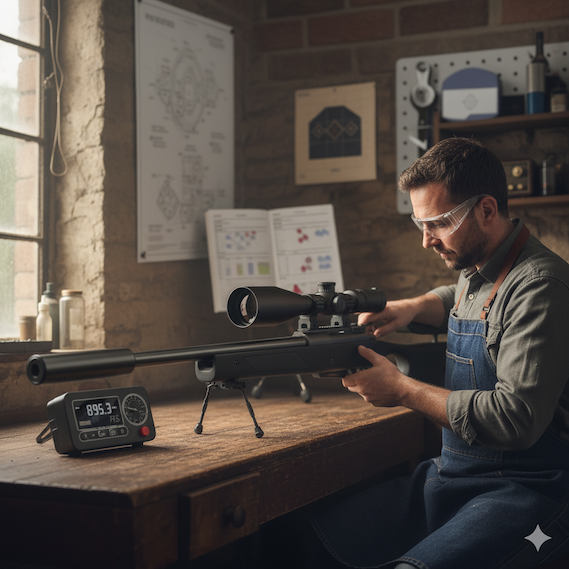
Systematic performance testing validates maintenance effectiveness and identifies developing issues before they affect shooting performance. Establish baseline performance metrics for comparison across maintenance intervals.
Conduct chronograph testing to verify velocity consistency and power output. Record group sizes at standard distances using consistent ammunition and shooting techniques. Document environmental conditions affecting results.
Compare current performance to historical data, identifying trends that indicate maintenance needs or component replacement requirements. This systematic approach enables proactive maintenance scheduling rather than reactive repairs.
Professional Maintenance Insights
Advanced Troubleshooting Techniques
Professional gunsmiths rely on systematic diagnostic approaches that go beyond basic maintenance procedures. These advanced techniques enable identification of subtle issues before they develop into performance-limiting problems or expensive repairs.
Pressure Drop Analysis represents one of the most valuable diagnostic techniques for any air rifle system. By measuring pressure retention across the entire firing cycle, you can identify internal leakage that might not manifest as obvious performance loss initially. Create a baseline pressure curve for your rifle when new or freshly serviced, then compare subsequent measurements to identify developing issues.
For spring-piston rifles, monitor the consistency of piston compression through careful chronograph analysis under varying conditions. Temperature sensitivity, shot-to-shot variation, and power curve changes throughout shooting sessions all provide diagnostic information about internal condition.
Sound Analysis provides surprisingly detailed diagnostic information for experienced ears. Each rifle develops its own acoustic signature that changes predictably with wear or maintenance needs. Recording your rifle’s firing signature can help identify developing issues, particularly in the compression system where pressure losses create subtle but detectable acoustic changes.
Precision Tuning Methods
Custom Lubrication Protocols represent advanced maintenance techniques that consider your specific rifle’s characteristics and operating conditions. Different mainspring materials, compression ratios, and operating environments require tailored lubrication approaches for optimal performance.
Develop custom lubrication schedules based on actual component wear rates rather than arbitrary time intervals. Monitor lubricant condition through systematic inspection, adjusting quantities and types based on observed performance.
Advanced Seal Conditioning goes beyond basic maintenance to optimise seal performance for specific applications. Competition rifles benefit from seals conditioned for maximum consistency, whilst hunting rifles need seals optimised for reliability under varying conditions.
The key to professional-level maintenance lies in understanding your rifle as a complete system rather than a collection of components. Each maintenance decision should consider its effects on overall performance, with adjustments made systematically rather than randomly.
Creating Your Maintenance Schedule
Frequency-Based Maintenance Planning
Establishing the right maintenance schedule requires balancing thorough care with practical shooting needs. Your rifle’s usage patterns, environmental exposure, and performance requirements all influence optimal maintenance timing.
Shot Count Intervals provide the most accurate maintenance scheduling method for active shooters. Track your shot count and perform specific maintenance tasks at predetermined intervals: basic cleaning every 500 shots, seal inspection every 2,000 shots, and comprehensive overhauls every 5,000-10,000 shots, adjusting these intervals based on your rifle’s specific needs and performance trends.
Seasonal Schedules work well for hunters whose shooting follows predictable patterns. Pre-season preparation ensures peak performance when hunting opportunities arise, whilst post-season overhauls address accumulated wear and prepare equipment for storage.
Environmental Condition Adjustments recognise that harsh conditions accelerate maintenance needs. Shooting in wet conditions, dusty environments, or extreme temperatures may require more frequent attention to specific components.
Documentation and Record Keeping
Systematic record keeping transforms maintenance from guesswork into precise equipment management. Professional shooters maintain detailed logs that track performance trends, identify optimal maintenance intervals, and provide valuable diagnostic information.
Record shot counts, environmental conditions, performance metrics, and maintenance activities in a systematic format. Digital spreadsheets or specialised apps can automate calculations and highlight trends that might otherwise go unnoticed.
Photography documents component condition over time, providing visual references for wear patterns and maintenance effectiveness. Before-and-after photos of cleaning procedures, component conditions, and reassembly details prove invaluable for future reference.
Performance data correlation helps identify the relationship between maintenance activities and shooting results. Tracking group sizes, velocity consistency, and accuracy trends relative to maintenance timing enables optimisation of your maintenance schedule for peak performance.
Your maintenance records also prove valuable for warranty claims, insurance purposes, and resale value documentation. Comprehensive maintenance histories demonstrate proper care and can significantly enhance equipment value.
Conclusion
Mastering air rifle maintenance transforms your relationship with your equipment from simple ownership to genuine partnership. The 12 essential maintenance tasks covered in this comprehensive guide provide the foundation for maintaining peak performance throughout your rifle’s working life, whether you’re pursuing competition excellence or reliable pest control effectiveness.
The investment in proper maintenance tools, products, and knowledge pays dividends far beyond simple cost savings on repairs. A systematically maintained rifle delivers consistent accuracy that builds confidence, reliable performance when it matters most, and longevity that preserves your investment for years to come.
Remember that maintenance represents an ongoing journey of understanding and caring for precision equipment. Your rifle’s specific needs will evolve with use, environmental exposure, and component wear patterns unique to your shooting style and conditions. The systematic approaches outlined here provide the framework for this lifelong learning process.
The distinction between recreational maintenance and professional-level care lies not in procedure complexity but in the systematic approach and attention to detail you bring to each task. Whether performing basic cleaning or advanced system overhauls, consistency and proper technique matter more than expensive tools or exotic products.
Begin by conducting a comprehensive assessment of your rifle’s current condition using the diagnostic techniques covered in this guide. Establish your maintenance schedule based on actual usage patterns and performance requirements rather than arbitrary intervals. Most importantly, approach each maintenance session as an opportunity to understand your equipment better whilst preserving its performance capabilities.
Professional servicing remains valuable for complex procedures or when problems exceed your comfort level, but the knowledge gained through systematic maintenance will make you a better shooter and more informed equipment owner regardless of who performs the actual work. Your commitment to proper maintenance ensures that your air rifle will continue delivering the precision and reliability that makes every shot count.
Check out our articles on:
How to maintain your air pistol
Discover the top 5 air pistol FAQs in the UK
Discover the top 3 glock air pistols
Discover the best spring-powered air pistols
Discover the best PCP air pistols
How to choose your first air pistol
Discover the best air pistol for rats
How to improving air pistol accuracy
Discover the best air pistol scopes and sights
